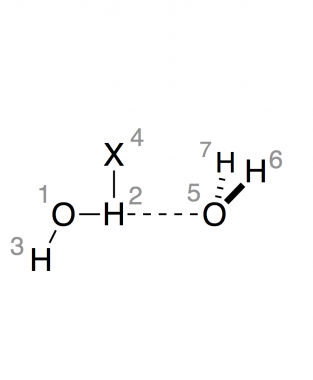Gaussian Input Files
The following is a typical Gaussian input file for the geometry optimization of the water dimer at the B3LYP-D3/6-31+G(d,p) level of theory.
%chk=/scr7/zipse/watdim01.chk %CPU=0-7 %mem=16000MB #p b3lyp/6-31+G(d,p) opt=(Z-Matrix) iop(1/7=30) int=ultrafine EmpiricalDispersion=GD3 watdim01 water dimer, B3LYP-D3/6-31+G(d,p) opt tight, Cs, int=ultrafine 0 1 O1 H2 1 r2 H3 1 r3 2 a3 X4 2 1.0 1 90.0 3 180.0 O5 2 r5 4 a5 1 180.0 H6 5 r6 2 a6 4 d6 H7 5 r6 2 a6 4 -d6 r2=0.9732 r3=0.9641 r5=1.9128 r6=0.9659 a3=105.9 a5=83.1 a6=112.1 d6=59.6 |
|
The first line of input defines the name and location of the (binary) checkpoint file, where information on the structure as well as the wavefunction of the system under study are permanently stored:
%chk=/scr7/zipse/watdim01.chk
The number of processors to be used for the particular calculation is specified next by:
%CPU=0-7
This calculation is to be run on a dual-processor workstation, where each of the processors has four compute cores. The overal eight cores are numbered sequentially from 0 to 7, and the above %CPU keyword line thus directs the program to use all eight compute cores for the calculation. How much main memory is to be used by the calculation is stated by:
%mem=16000MB
followed by a line with keywords defining the actual type of calculation that will be performed. This line starts with the "#" sign, the directly following symbol "P" indicating a more extended output format. The type of quantum chemical calculation we want to do is defined by "b3lyp". This commonly used hybrid DFT method is in this case combined with the 6-31+G(d,p) basis set. The keyword "opt=Z-Matrix" implies that the geometry optimization will be performed in the Z-Matrix coordinate system defined a few lines later, which is frequently done when optimizing structures of higher symmetry. To what convergence criterion the optimization will be done is defined by "iop(1/7=30)", which is otherwise equivalent to "opt=tight", but more flexible to use. Numerical integrations in energy and gradient calculations will use the "ultrafine" grid, and the "EmpiricalDispersion=GD3" keyword instructs the program to combined the B3LYP energy calculations with the appropriate Grimme-style D3 dispersion correction.
#P b3lyp/6-31+G(d,p) opt=(Z-Matrix) iop(1/7=30) int=ultrafine EmpiricalDispersion=GD3
Keywords can be listed on more than one line, and the keyword input section is ultimately terminated by a blank line. Comments can then be given in a free-format comments section, again terminated by a blank line. This may, for example, include the job name of the calculation, some remarks on the methods used, or on the symmetry of the system.
watdim01 water dimer, B3LYP-D3/6-31+G(d,p) opt tight, Cs, int=ultrafine
The overall charge (0 = neutral system) and multiplicity (1 = singlet state) is defined next:
0 1
directly followed by the geometry definition of the system. The particular Z-Matrix format chosen here is not only used for defining the geometry, but also provides the coordinate system, in which the geometry optimization will be performed. A dummy atom "X4" is used to define the angular orientation of the two water molecules relative to each other.
